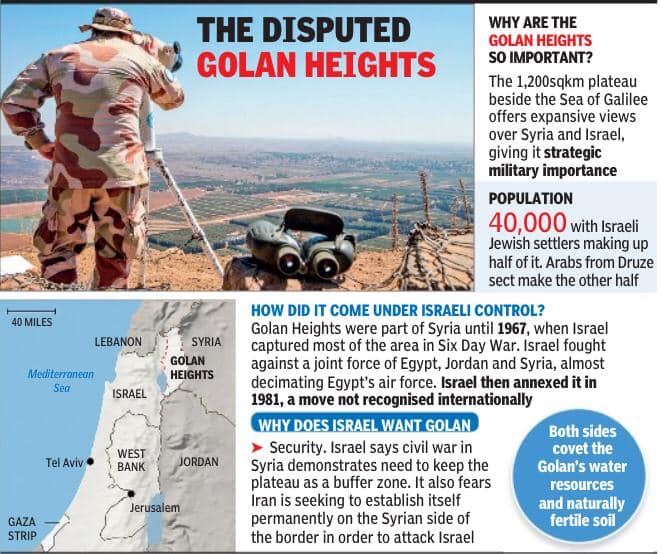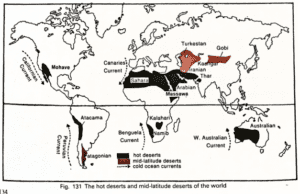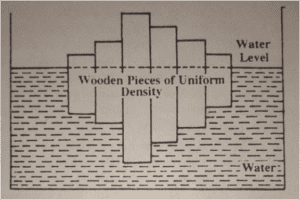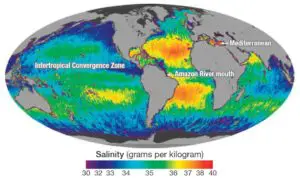Table of Contents
Golan Heights Dispute | U.S, Israel and Syria | Significance | UPSC – IAS
The Golan Heights, or simply the Golan, is a region in the Levant, spanning about 1,800 square kilometres. as a geopolitical region, the Golan Heights is the area captured from Syria and occupied by Israel during the Six-Day War, territory which Israel effectively annexed in 1981. This region includes the western two-thirds of the geological Golan Heights and the Israeli-occupied part of Mount Hermon.
Golan Heights Issue
Recently, United states of America, President Donald Trump has announced that the US may recognize Israeli sovereignty over the Golan Heights. The U.S. will be the first country to recognize Israeli sovereignty over the Golan and marks a dramatic shift in U.S. policy.
Timeline of the Golan Heights dispute | UPSC – IAS
- The Golan Heights were part of Syria until 1967.
- In 1967, Israel occupied the Golan Heights, West Bank, East Jerusalem, and the Gaza Strip in the 1967 (most of the area) in the Six Day War.
- Syria tried to regain the Golan Heights during the 1973 Middle East war. Syria was defeated in its attempt and all the effort was thwarted.
- Both countries signed an armistice in 1974 and a UN observer force has been in place on the ceasefire line since 1974 and the Golan had been relatively quiet since.
- In 1981, Israel permanently acquired the territory of the Golan Heights and East Jerusalem (which was not recognized Internationally). An armistice line was established and the region came under Israeli military control.
- After annexing the Golan Heights, Israel gave the Druze population the option of citizenship, but most rejected it and still identify them as Syrians.
- In 2000, Israel and Syria held their highest-level talks over a possible return of the Golan and a peace agreement. But the negotiations and subsequent talks failed.
- The area remained under rebel control until the summer of 2018.
- Assad’s forces are now back in control of the Syrian side of the Quneitra crossing which reopened in October 2018.
International Recognition of Golan Heights | UPSC – IAS
- The European Union said its position on the status of the Golan Heights was unchanged and it did not recognize Israeli sovereignty over the area.
- The Arab League, which suspended Syria in 2011 after the start of its civil war has said the move is “completely beyond international law”.
- Egypt, which made peace with Israel in 1979, said it still considers the Golan as occupied Syrian territory.
- India has also not recognized Golan heights as Israel territory and has called for the return of Golan Heights to Syria.
- The international community regards as disputed territory occupied by Israel whose status should be determined by negotiations between Israel and Syria.
- Attempts by the international community to bring Israel and Syria for negotiations have failed.
Significance of Golan Heights Dispute | UPSC – IAS
- The Golan Heights topography provides a natural buffer (Protection against attack) against any military attack from Syria.
- Golan Heights Natural resources – key source of water for an arid region. Rainwater from the Golan’s catchment feeds into the Jordan River.
- Naturally fertile soil and the volcanic soil is used to cultivate vineyards and orchards and raise cattle.
Analysis of Golan Heights Issue | U.S and Israel | UPSC – IAS
U.S. WILL BE THE FIRST COUNTRY TO RECOGNIZE ISRAELI SOVEREIGNTY OVER THE GOLAN
- U.S. President Donald Trump’s has already recognised as Israel’s capital Jerusalem, a city it captured in parts in the 1948 and 1967 wars and which is claimed by both Israelis and Palestinians.
- Israel captured Golan, a strategically important plateau beside the Sea of Galilee, from Syria in the 1967 war. Among the territories it captured in the war, Israel has returned only the Sinai Peninsula, to Egypt.
- It annexed East Jerusalem and Golan Heights and continues to occupy the West Bank and the Gaza Strip.
- In 1981, as it passed the Golan annexation legislation, the Security Council passed a resolution that said, “the Israeli decision to impose its laws, jurisdiction and administration in the occupied Syrian Golan Heights is null and void and without international legal effect
- Unlike Egypt in the 1970s, Syria has had neither the military ability nor the international clout to launch a campaign to get its territory back.
- President Bashar al Assad tried to kickstart a United states mediated peace process with Israel during the Obama presidency, but it failed to take off.
- And now, the Syrian government, after fighting eight years of a civil war, is debilitated and isolated, and the United States move is unlikely to trigger any strong response, even from the Arab world.
- But that is the least of the problems. Mr. Trump’s decision flouts international norms and consensus, and sets a dangerous precedent for nations involved in conflicts.
- The decision also overlooks the wishes of the inhabitants of the territory. Most of the Druze population that has been living in Golan for generations has resist ed Israel’s offer of citizenship and remained loyal to Syria.
- Mr. Donald Trump is making the possibility of any future peaceful settlement difficult by recognising Israel’s sovereignty, just as he made any future Israeli Palestinian settlement complicated with his decision to move the U.S. embassy to Jerusalem from Tel Aviv.
- The modern international system is built on sovereignty, and every nation state is supposed to be an equal player before international laws irrespective of its military or economic might.




